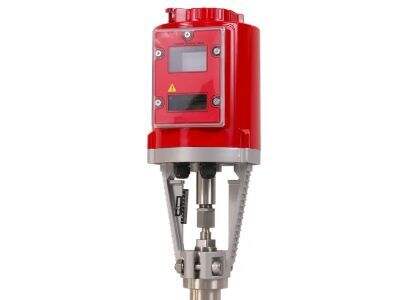Машиналар қалай қозғалады және қалай жұмыс істейді туралы қызықсыз ба? Көптеген машиналарда ең маңызды және пивотал компоненттердің бірі - пневматикалық актюатор деп аталады. Мүмкін, соңғы сөз қиын санылады, бірақ біз сізге оны қарапайым болатындай түсіндіреміз. Бұл кіріспе аяқталғанда, сіз пневматикалық актюатор қандай, оның қалай жұмыс істейтіні және машиналар үшін неше маңыздығы туралы білесіз.
Пневматикалық актюатор қандай?
Пневматикалық актюатор машина қозғалысын орындау үшін пайдаланатын максаттағы компонент. Ол ҳава пайдаланып қозғалыс жасайды. Балонды толтыруға ұқсайтын. Балонды шығар, ғана әріп шығып, балон әртүрлі жерлерде қозғалады. Осы принцип машиналарда да қолданылады. пневматикалық актуатор олар құрал деп аталатын поршень немесе диафрагмаға сірек қуыршақты қолданады. Бұл қуыршақ әрекетті жасайды. Бұл әрекет колесерді айналдыру, көлбеулерді қозғалту және шеңберлерді жоғары-төмен қозғалту үшін пайдаланылады. Пневматикалық актюаторлар өте мүмкіндіктерге ие және түрлі машиналарда қолданылады.
Пневматикалық актюаторлар қалай жұмыс істейді: түрлері және әртүрлі қолданбалар
Машина үшін Пневматика – Машиналарда қолданылатын әртүрлі түрлерде пневматикалық актюаторлар бар. Основные түрлер мына жерде берілген:
Бірбалақты цилиндр: бір жағынан екі жағына қарағанда қуыршақ қолданылатын актюатор. Поршень қуыршақ басқанда суырғанда. Бірақ қуыршақ шығарылғанда, пружина поршені бастапқы орнына қайтарады. Қысқаша — мағаныс және бір бағытта қозғалатын кіші машиналарда қолданылатын жалғыз.
Екі таңдаулы цилиндр: Бұл типтегі әрекетші екі жағында да һава басындығы бар. Оны қозғалтатын және артқа қайта отыратын болуы мүмкін. Бұл, көпірлі машиналарға арналған Superlkeger, олар екі немесе одан көп бағытта қозғалыс орындау керек болғанда, мысалы, шейкендерді қозғалту.
Тұралы әрекетші: Бұл қос-жоғары бөлшектік пеньюматикалық әрекетші бар машинаға сәйкес нәтижелерді айналдырады. Ол артқа және алдыға қозғалмайды, бірақ айналдыру немесе құрғауға көмектеседі. Мысалы, олар қапты ашу немесе жабу, немесе арбасын айналдыруға мүмкіндік береді. Кері бағытта қажет ететін көптеген машиналар үшін маңызды.
Әрекетшілердің бірнеше түрлері бар, әрқайсысы өз қолайлылықтары мен қиындықтарымен. Машина қандай мақсатқа жетуі керек болса, бір түрі екіншісінен жақсы болуы мүмкін. Екі таңдаулы цилиндр – кішкентай іşтерді орындауға жақсы, ал екі таңдаулы цилиндр көпшілікте үлкен ішемдер үшін әдетте қажет.
Ең жақсы пеньюматикалық әрекетшін қалай таңдау
Қолданудың қажетті пневматикалық актуаторын таңдау кезінде көбінесе факторларды ескере отырып болады. Бұл сұрақтарға жауап беруге тырысыз:
Сізге қанша күш қажет? Бұл актуатордың істерін жақсарту үшін қанша дайын болуы керек.
Оны қай бойымен жиберу керек? Сіз оны қандай аймақта қолдануға болатынын білмейдіңіз.
Сіздің қозғалтыңыз объекті неше үлкен және қалай қ Towers? Актуатор объектін шығару немесе қозғалту үшін жеткілікті қуатты болуы керек.
Актуатор үшін қандай орналасу мүмкін? Орналасуы мен жұмыс істейтін актуаторды тексеру қажет.
Идеалды актуаторды таңдау өте маңызды – қате актуатор мәселелер шығара алады. Бұл машиналарды қорғайды немесе оның қате жұмыс істеуіне себеп болады, бұл уақыттың және қосымша траттарын өтеді.
Пневматикалық актуаторларды сақтау
Пневматикалық актуаторлар немесе on off valve пневматикалық актуатор машиннің басқа машиналарға салыстырылғанда, олар өзгекті жұмыс істей алатындықтан, оларға бағытталған қажетті тиімділік беру керек. Айдың немесе тоғыздың бойынша техникалық қызмет. Ол әртүрлі негізгі әрекеттерден тұруы мүмкін:
Жабықтықтарды тексеру: Жабықтықтардың болуы мүмкін емес, сондықтан сіз жабықтықтарға қараңыз, ол әрекетшінің қызметкерлігін кемітеді.
Ескі және созылған компоненттерді алмастыру: Белгілі компоненттер ұзақ уақыт қолданылса, әрекетші дамыту үшін оларды алмастыру маңызды.
Оларды смазкаға қою: Тиімді смазка бөліктердің қозғалысын ыңғайлаған және зиян алмасады.
Әрекетшімен қате шығса да, оның тез ретте түзетілуі маңызды. Кіші қателерді қарастырмағанда, соңында үлкен қателерді шешуге қанағатта уақыт және пул сапалауы мүмкін.
Пневматикалық әрекетшілер санайлық ауданда
Пневматикалық қолданбалардың негізгі мысалдары – заводтар және сабақ шекаралары. Олар ғумбездерді тәуелсізге және адамның кіші көмегімен жұмыс істейтін етістіктерге айналдырады. Бұл автоматтық деп аталады. Жұмысты автоматтық түрде орындау оны жылдам және дәл етеді. Сонымен қатар, ол адамның қателерін кемиді.
Сондықтан, пневматикалық актуаторларды қолданатын жақсы машина сағат сияқты жұмыс істей алуы керек. Егер бір қисық оның келесіндегі тапсырмасын орында бермейсе, бүкіл жүйе тенденциясына қarama-қарсы болуы мүмкін. Пневматикалық актуаторлар сенсорлар мен контроллерлерді қолдана отырып, машина элементтері арасындағы байланысты жақсылауға көмектеседі. Бұл барлық технологиялар бір-бірімен жақсы әрекет етуді қамтамасыз етеді.
Жалғастыруымен, пневматикалық актюаторлар - пневматикалық актюаторлар функциясы түсіндірілген: кез келген уақытта һава қолданылғанда, сіз машинаның істемесі үшін ол неге өте маңызды екенін білесіз. Берілген мәселені шешу үшін әртүрлі түрдегі актюаторлар бар, сондықтан да берілген мәселені шешуге арналған ең жақсы актюаторды таңдау маңызды. Оларды жақсы жағдайда сақтау үшін регулярлық техникалық көмек көрсету де маңызды. Жалғастыруымен, пневматикалық актюаторлар - машина істей алатын құрылғы, олар басқарымға қажет болатын басық һава пайдаланады, олардың бірігіп табысыз қызметтерде, тексерілген жылдамдық пен дәлдікпен жұмыс істейтін фабрикаларда пайдаланылады.
 EN
EN AR
AR
 CS
CS
 FR
FR
 HI
HI
 KO
KO
 PL
PL
 PT
PT
 RO
RO
 RU
RU
 ES
ES
 TL
TL
 IW
IW
 ID
ID
 LT
LT
 SR
SR
 SL
SL
 UK
UK
 VI
VI
 ET
ET
 HU
HU
 TH
TH
 TR
TR
 FA
FA
 MS
MS
 UR
UR
 BN
BN
 JW
JW
 MN
MN
 NE
NE
 TA
TA
 MY
MY
 KK
KK
 UZ
UZ
 KY
KY



